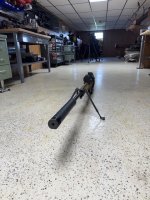I am from Finland, and we have a long, well i would say medium time on the history in firearms, that we have been able
to use suppressor, and for sure they are made to reduce the muzzle blast and reduce the sound.
And this is the purpose of suppressor in these days too.
But in sport shooting, the spotting of the own shot´s in few different competition, or even on a hobby shooter, it is nice to able to spot your own shot´s.
I have seen quite many USA suppressor manufacturers, that offers the muzzle brake on the tip of the suppressor.
We have a coversation on a Finnish forum of this subject, and there are only me and one other guy that do think that the brake will
help to reduce the rest of the gas burst that come from the suppressor, since the suppressor by it self it is not doing the recoil reduce that much, it does
kind of push the gun, and not killing the recoil, like a pure muzzle brake on the barrel does.
But the thing is, how much does the suppressor with a muzzle brake on it reduce the recoil, is it proniment?
I have shot few suppressor that has a muzzle brake, and i can say that it does work.
But since you have more companies and users in USA these days, what is your thoughts of this?
Will the suppressor with a brake make the rifle more stable?
King by him self just made a video about this same thing yeasterday, and i would love to see a longer video from Frank about this subject.
to use suppressor, and for sure they are made to reduce the muzzle blast and reduce the sound.
And this is the purpose of suppressor in these days too.
But in sport shooting, the spotting of the own shot´s in few different competition, or even on a hobby shooter, it is nice to able to spot your own shot´s.
I have seen quite many USA suppressor manufacturers, that offers the muzzle brake on the tip of the suppressor.
We have a coversation on a Finnish forum of this subject, and there are only me and one other guy that do think that the brake will
help to reduce the rest of the gas burst that come from the suppressor, since the suppressor by it self it is not doing the recoil reduce that much, it does
kind of push the gun, and not killing the recoil, like a pure muzzle brake on the barrel does.
But the thing is, how much does the suppressor with a muzzle brake on it reduce the recoil, is it proniment?
I have shot few suppressor that has a muzzle brake, and i can say that it does work.
But since you have more companies and users in USA these days, what is your thoughts of this?
Will the suppressor with a brake make the rifle more stable?
King by him self just made a video about this same thing yeasterday, and i would love to see a longer video from Frank about this subject.





